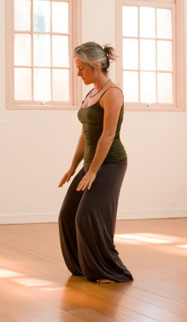Debbie Rosas and Carlos Rosas created Nia in the early 1980's as a more intelligent and less painful way to workout and stay fit. Since then it has spread across the United States and to many other countries where teachers and studios can be found.
Generally Nia is taught to groups of 10 or more people and does not require any equipment. Some of the benefits include and increase in the pleasure of living in your body, help with weight loss and maintenance, improved mucsle tone and strength, more endurance, a better ability to deal with stress and stay calm, improved posture, better concentration, a happier emotional state and much more.
Based on both Eastern and Western philosophy Nia, or "Neuromuscular Integrative Action," helps to heal the body, spirit, mind and emotions. It is a fusion of many different movement forms inclucing Yoga, Tai Chi, Jazz, Duncan, Modern, Aikido, Tae Kwon Do, Feldenkrais and The Alexander Technique.
Designed to be both therapeutic and fun it is set up similar to the martial arts with belts awarded for progress and mastery starting with white and proceeding up to black. Those at the highest level are considered to be Movement Medicine Healers.
Following is an article which appeared in Business Week on this fabulous exercise routine.
BUSINESS WEEK ONLINE: MAY 10, 1999
PERSONAL BUSINESS
A Calmer, Saner Way to Stay Fit
Aerobics made Carla Warnecke tense. ''Everyone was beating themselves up. Boom, boom, boom, up and down,'' she says. So after experimenting with fitness alternatives such as jazzercise and rhythmic boxing, the 40-year-old research assistant at the University of Texas M.D. Anderson Cancer Center in Houston found NIA. Short for neuromuscular integrative action, the technique lets Warnecke stay fit in a ''much calmer and saner'' manner.
NIA participants do sweat all right, through an amalgam of martial arts, yoga, and dance. Though the workout was developed in 1983, by Carlos and Debbie Rosas, at Debbie's Santa Rosa (Calif.) aerobics studio, NIA is finally catching on. The technique emphasizes conditioning the mind as well as the body, and it has taken years to train instructors on the exercises' subtleties. ''It's a blend of the best components that came before,'' says Ralph La Forge, an exercise physiologist at Duke University Medical Center. La Forge recommends the technique for heart patients and people who want to lower their cholesterol.
NIA classes typically last one hour and cost $10 to $15. You can find classes by contacting NIA Technique in Portland, Ore. (503) 245-9886, www.nianow.com). Sessions begin with deep-breathing exercises, during which you meditate on the feeling of your bare feet against the floor. Initial movements, to soft background music, are slow and steady; no drill sergeant will bark out orders to jump up and down. Instructors depend instead on visualization, says Debbie Rosas. For example, you may be asked to wave your arms back and forth as if you are stroking the tips of tall grass. As the music gradually speeds up, so do the ballroom dance-type steps (heel-toe-slide-dip).
Vocalization is also part of the experience. During a tae kwon do-style kick, you might be asked to emit a guttural ''huh!'' or shout ''yes'' while throwing your arms skyward. You get constant reminders to clear your mind of everything except what your body is doing and feeling, says Helen Terry in Houston, one of 400 certified NIA instructors in the U.S. Indeed, a 1997 study published in the journal Women's Health Issues found that NIA relieved anxiety more effectively than aerobics. As with aerobics, more women tend to participate.
Routines vary from class to class. While conceived as a total body workout, sessions may focus on stretching and strengthening a particular group of muscles. The ambient music changes too, ranging from ecclesiastical choral arrangements to technofunk. Just as varied are the NIA-phytes. ''You'll find all ages and all levels of physical ability,'' Terry says. There are three degrees of difficulty for almost every movement, ''so you can make your workout as challenging as you want.''
The overriding NIA principle is pleasure. Do what feels good and invigorating; avoid anything that hurts or is exhausting. ''You get to play,'' says Warnecke, who appreciates the latitude to tailor her movements according to her skill, mood, and sense of rhythm.
PERFECT PITCH. Even without jumping around, the NIA technique burns calories. Terry dropped from size 16 to size 8 without any change to her diet in a year. NIA gets the pulse rate up, but it does so without risking the injuries common in aerobics and other high-impact forms of exercise. Dr. James Garrick, director of the Center for Sports Medicine at St. Francis Hospital in San Francisco, says he sends recovering orthopedic patients to NIA classes. ''It's a great way for them to get fit without re-injuring themselves,'' he says.
In NIA classes, everybody does their own thing, but in an orchestrated way--as if they were all singing the same song, but at different octaves. Whether your pitch is high or low, the result is improved tone.
By Kate Murphy
For more information about Nia go to www.nianow.com. For information about cleansing read about Isagenix Cleanse.

